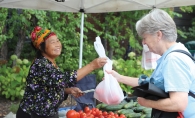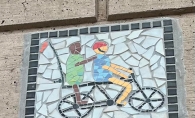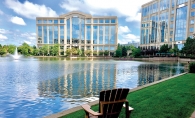There was a time, not long ago, when the bells of the streetcar were a familiar sound amid the hustle and bustle of the Twin Cities. Businessmen commuted downtown, families hopped aboard for a quick escape to the lake and Edina was conveniently situated along the path, an early player in the public transportation system. But since 1954 the streetcar line has been silent, and in its place the automobile has become the primary means of transportation. While cars provide great individual freedom, communities across the nation are questioning the future of their transportation needs—particularly as they consider rapid changes to the environment, economy and technology. “Americans may love their cars, but I think Americans love something more than their cars: they love having lots of choices” says Jay Walljasper, a metro-area resident who writes, speaks and consults on vital communities. One of the choices coming to Edina within the next decade will be the Southwest Corridor light rail line, which will break ground in 2015. Although the path will not travel directly through the city limits, it has city officials and planners engaged in conversation about the future of transportation and how Edina will embrace the new approach. Some say it’s an ambitious goal, but the Southwest Corridor light rail is scheduled to begin operation in 2018. Edina city leaders, such as city council member Mary Brindle, are eager to make this third light rail line a reality, once the Central Corridor is up and running. “With [the] Hiawatha [line], they learned that the population that uses light rail is much greater than expected,” says Brindle. When the Southwest LRT, to be called the “green line” is complete, Edina residents will have access to 17 stations between the downtown Minneapolis interchange and Mitchell Road. An extension of the central corridor, the “green line” will run through St. Louis Park, Hopkins and Minnetonka, along what was once the old streetcar line and the current LRT bike trail. “Right now it’s a spoke system,” explains Brindle. “But we’re hoping to eventually connect it on the outside so you won’t have to go into Minneapolis to get somewhere.” Although light rail is the most glamorous addition to local public transportation, the new system will include a combination of light rail, bus, bus rapid transit, and biking options to help residents of the Twin Cities on their daily commutes. For Edina, this mixture of services is crucial, since the nearest LRT stop will be in St. Louis Park or Hopkins. Although discussions are still underway, Brindle expects some sort of shuttle system and revamped sidewalks and biking lanes. Katie Walker, the senior administrative manager of Southwest LRT Community Works, says Nice Ride kiosks, which rent bikes that can be dropped off at locations around the metro, could be installed at light rail stations, along with other bike amenities. “We have a very strong biking community along the southwest,” she says. Improvements in the roadways and bike paths are already underway as part of the effort to encourage Edina residents to use various modes of transportation. Just last summer the city added bike lanes to 10 miles of roadway, and it plans to retrofit the city with sidewalks in the years ahead. “To get more people to bike [in the 21st century] you have to create an environment that feels and looks safer,” says Walljasper. “The great thing about that is it makes the streets safer for everyone.” Bike lanes and sidewalks are only part of the city’s bigger plans to implement a Living Streets policy. Paul Nelson, chair of the city’s transportation commission, explains the policy as a plan for creating city streets that encourage multiple uses. If the City Council adopts the policy, Edina will see more streets that have designated automobile, bus routes, bike lanes, crossings and parking; and a system for managing stormwater runoff, such as rain gardens. “It will take a while to build the whole system out,” acknowledges Nelson, who sees this as a long-term plan. Although motorists may grumble at reduced lanes of traffic, Nelson believes it will help make for a healthier population and give people more transportation options. “We’re making it more equitable for all people to choose their transportation,” he says. There will undoubtedly be a period of adjustment, as people try on their new transportation options. “Change is difficult, and some [people] are more ready for it than others,” says Nelson. Lori Syverson, president of the Edina Chamber of Commerce, thinks younger residents will be the most receptive. “They want to live in a tight, interconnected community, with theater, arts, restaurants and shopping, and a big piece of that puzzle is transportation,” she says. Walljasper agrees that we’re on the brink of a generational shift. For the older generations “the car was a symbol of freedom of expression and exploration,” he suggests, but for the millennials, “the car is simply a way to get from one point to another.” In fact, for the millennials, computers and technology might fill more of that self-expression role, he adds, and they’re easier to use while riding public transit. Edina city officials understand the value of appealing to the younger generation by participating in light rail and public transportation developments. “There are jobs here,” says Brindle. “We might be able to attract the young professional who prefers mass transit.” Syverson has spoken with local companies on the topic, many of which have indicated that transportation plays a role when planning for the future. Walljasper points out that Edina, and the Twin Cities in general, is competing in a global economy, “so it’s important we continue to attract investment and sought-after workers. In order for Edina to remain Edina, [it] has to remain a place that is economically attractive to people moving in from elsewhere … and transit seems to be a big part of that equation,” he says. For decades, Edina has been considered a suburb, with many residents commuting into the cities for work, or living and working within Edina. Brindle anticipates a change in commuter traffic in the years ahead, with many residents of other towns traveling via light rail to Edina. “You’re going to have people going in both directions,” she says. Walker confirms that the green line will be a jobs corridor, but it also has community facilities and recreation options along its path, such as Shady Oak Lake in Minnetonka, that will encourage public transportation usage for purposes other than work. Public transportation has long fought a negative stigma of being a last-resort option, but with the advent of light rail and improvements in rapid bus transit, a new image is on the horizon. Natural-fuel buses are a noticeably smoother ride, and they “offer the comfort and convenience of light rail but run on rubber tires,” says Walljasper. And if Edina’s love for streetcars was any indication of how light rail will fare, public transportation is about to become the next big thing. & For more information on the Southwest LRT, visit southwesttransitway.org
Menu
From the July 2013 issue
Southwest LRT Sparks Conversation in Edina
With light rail on the horizon, Edina envisions the future.
Photo by:
MetroTransit









